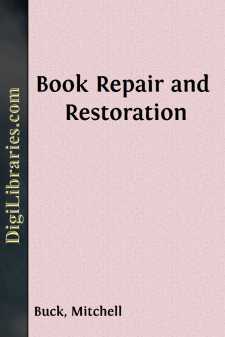Categories
- Antiques & Collectibles 13
- Architecture 36
- Art 48
- Bibles 22
- Biography & Autobiography 813
- Body, Mind & Spirit 142
- Business & Economics 28
- Children's Books 15
- Children's Fiction 12
- Computers 4
- Cooking 94
- Crafts & Hobbies 4
- Drama 346
- Education 46
- Family & Relationships 57
- Fiction 11829
- Games 19
- Gardening 17
- Health & Fitness 34
- History 1377
- House & Home 1
- Humor 147
- Juvenile Fiction 1873
- Juvenile Nonfiction 202
- Language Arts & Disciplines 88
- Law 16
- Literary Collections 686
- Literary Criticism 179
- Mathematics 13
- Medical 41
- Music 40
- Nature 179
- Non-Classifiable 1768
- Performing Arts 7
- Periodicals 1453
- Philosophy 64
- Photography 2
- Poetry 896
- Political Science 203
- Psychology 42
- Reference 154
- Religion 513
- Science 126
- Self-Help 84
- Social Science 81
- Sports & Recreation 34
- Study Aids 3
- Technology & Engineering 59
- Transportation 23
- Travel 463
- True Crime 29
Book Repair and Restoration
by: Mitchell Buck
Description:
Excerpt
CHAPTER I
GENERAL RESTORATION
To consider first a few simple processes of ordinary restoration, let us assume that a rare book in its original cloth or boards, in a more or less damaged condition but not to the point of necessitating rebinding, has just been received.
The first operation required is to carefully clean off the binding with a soft cloth, wipe off the end papers, which often have a coating of dust, especially when the covers do not fit closely, and, if the top is gilt, wipe that carefully also. An “uncut” top is freed from dust by brushing with a soft brush.
The book is then collated to make sure that every page is in place and, if there are plates, that no plate is missing. This operation, it is perhaps needless to say, should by all means be done before purchasing, unless the book comes from a reliable dealer to whom an imperfect copy could be returned. If, in collating an old book, the amateur discovers that page 173 follows immediately after page 136, he need not necessarily be alarmed, as mistakes in pagination and even in the numbering of signatures are very common in books printed a century or more ago. In such cases, the “catch words” which generally appear at the bottom of the pages, or else the text itself, should be examined to see whether the page, without regard for its number, is really in its proper place or not. Each page is then examined for dirt or finger marks, which can almost always be removed, the quality of the paper permitting, with a soft pencil-eraser or bread crumbs.
Marginal notes, especially in contemporary hands, are much better left alone; they are often of considerable value and, when neatly and not excessively done, rather add to the interest of the volume without detracting from its value to any great extent. On which subject Bonnardot has quite a little to say, in the chapter on Stains included in this volume.
Presentation inscriptions in the autograph of the author or of some one intimately connected with him of course greatly increase the interest and value of the book. Names written on title-pages can often be effaced by the process elsewhere described, but these should not be disturbed until they have been thoroughly investigated. A name which at the moment seems totally unfamiliar may sometimes be found of special interest inscribed in the particular volume in which it is found. As an ordinary illustration of this, might be mentioned a copy of Edwin Arnold’s “Gulistan” bearing on the half-title the inscription “To dear Mrs. Stone from Tama.” This author had, at one time, married a Japanese girl, and a little investigation revealed that her name was Tama KuroKawa. Her inscription, of course, remains undisturbed, as it adds a distinctly personal note to the volume. But alas! the John Diddles and William Bubbles who have for centuries scribbled their odious names over fair title-pages, with never the grace to make themselves immortal and their autographs a find!
Writing in the year 1345, Richard de Bury remarks, “When defects are found in books, they should be repaired at once....


